Graphene, if you haven’t yet heard, may just be the most exciting material discovery of the last 50 years or more.
Graphene has the potential to usher in the future that many dreamers, inventors, and science-fiction writers have been hoping for since the discovery of electricity and the invention of computers and spaceflight. Simply put, graphene is a super material that keeps astonishing researchers with its properties and possible uses.
Graphene is an allotrope (meaning a physical version) of carbon made of a single layer of carbon atoms formed into a hexagonal lattice. This is the basic structure upon which many other allotropes of carbon are based, including graphite, charcoal, and even the carbon nano tubes Richard Mille is so fond of.
The properties of graphene are as strange as they incredible: high flexibility, high ductility, high electrical conductivity and high thermal conductivity. But that’s not all, not by a long way; graphene is also largely and nonlinearly diamagnetic (repelled by magnetic fields), virtually transparent, and super-permeable to water (allowing practically perfect evaporative diffusion), yet impermeable to any other gases or liquids, even the smallest atomic-size gas, helium.
Oh, and then there’s the fact that graphene is the strongest material ever tested.
The strongest material ever tested!
Chemistry nerd side note: an allotrope is a different physical form in which an element can exist. Depending on the way in which atoms of an element combine and bond, allotropes can take many different forms. There are as many as 500 different allotrope possibilities for carbon, though only a fraction of them have been observed. The most well-known allotropes of carbon are diamond (tetrahedrons forming a three dimensional lattice); graphite (layers of hexagonal lattice sheets); graphene (single layer of hexagonal lattice); buckminsterfullerenes, aka “buckyballs” (fullerenes being hexagonal lattice forming into a sphere or ellipsoid from the inclusion of pentagons); and a subset of the fullerene structural family, carbon nano tubes (hexagonal lattice formed into a cylinder).
Basically, graphene, which was theoretically discovered in the 1970s and first successfully isolated in 2004 (using a piece of Scotch tape), is the material that might touch nearly every industry in some way and completely change the trajectory of material science for many others. It might replace silicon in many of its uses, and might make reinforced composites so much stronger that their possible applications expand considerably.
One of the biggest benefits in the near future that I am most looking forward to comes from energy storage solutions that are theoretically possible with graphene-based battery systems.
Researchers and companies are racing to incorporate it into real-world applications focusing on one or many of its unique properties. Regardless of how graphene is used or may be used in the future, it stands poised to help jumpstart the next era of technological advancement, all thanks to a piece of sticky tape.
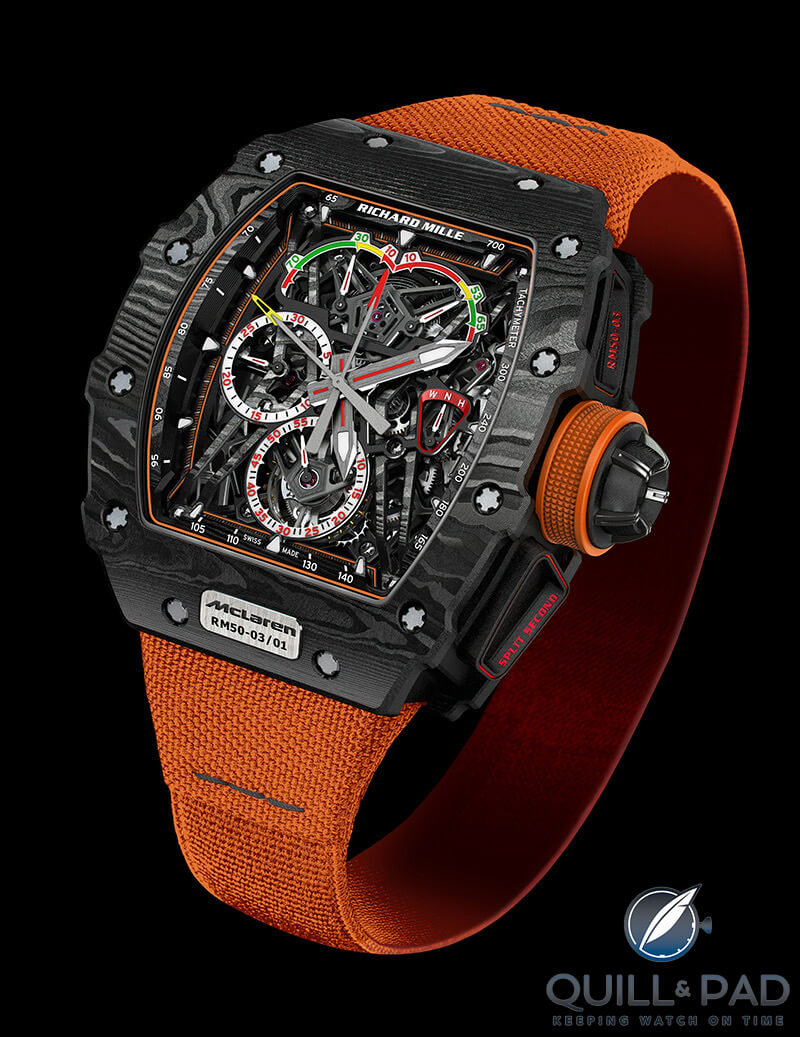
Richard Mille RM 50-03 Tourbillon Split Seconds Chronograph Ultralight McLaren F1
Two companies most of us are familiar with, McLaren and Richard Mille, have teamed up to apply it as a first in the watch industry, releasing initial fruits of that labor as the Richard Mille RM 50-03 Tourbillon Split Seconds Chronograph Ultralight McLaren F1.
RM 50-03: a legacy renewed
But before we dive into the watch, let’s look into a little background to show just how deep the connection between Richard Mille and McLaren goes.
It all started in 1966 at the Monaco Grand Prix. Richard Mille attended the race with his father; it was the very first Formula 1 race that Mille ever saw. Also a first that day: Bruce McLaren debuted his very first Formula 1 car, the M2B. In 1981, eleven years after the tragic death of McLaren, the company he founded was still going strong and introduced a first in Formula 1: a carbon fiber chassis.
Years later, when Mille launched his eponymous brand, he focused on atypical luxury materials like titanium, ceramics, and composites just like McLaren had been doing for years. As the Richard Mille brand grew, Mille expanded his reach into the automotive and racing world by partnering with and sponsoring drivers and teams from F1, rally, Le Mans, and Formula E. And he helped launch the Chantilly Arts & Elegance, the first concours d’elegance held in France since the 1930s.
During this time Richard Mille also came full circle with McLaren, purchasing the original McLaren M2B race car from the Monaco Grand Prix in 1966.
So when I heard that Richard Mille had just signed a ten-year partnership deal with McLaren-Honda (see McLaren Formula 1 Team Announces Richard Mille As New Sponsoring Partner), I honestly thought they already were partners; that is how much the partnership made sense.
For the new partner’s inaugural debut, Richard Mille presented another world first: the first watch case featuring Graph-TPT, a thin-ply technology composite featuring graphene-enhanced resin. Now while that might sound like a just another cool thing Richard Mille has made it is much more than that, and the launch of the RM 50-03 proved it.
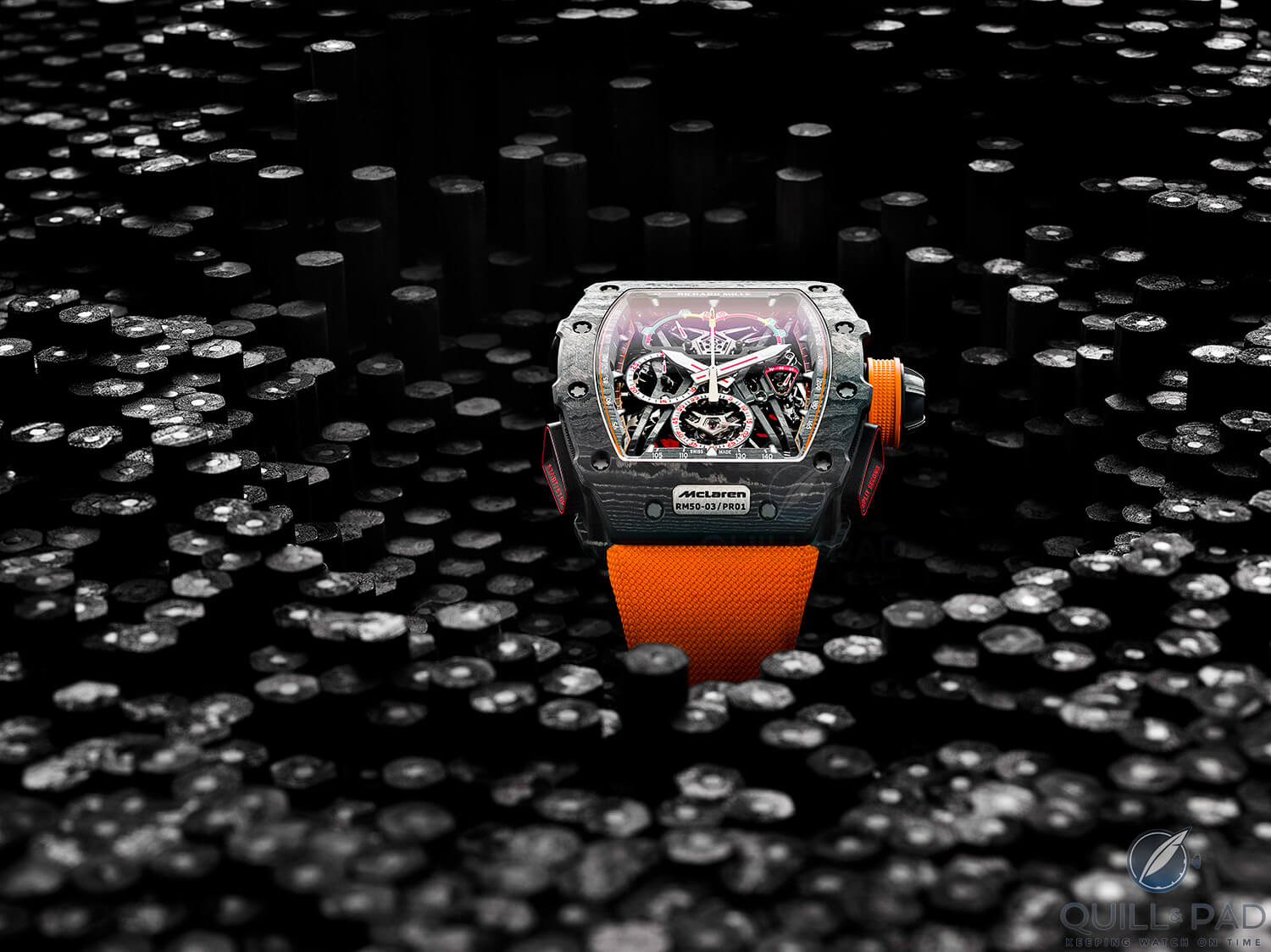
Richard Mille RM 50-03 (photo courtesy Richard Mille/Ted Humble-Smith)
The RM 50-03 emphasizes technical innovation
When Richard Mille debuted the RM 50-03 during SIHH 2017, the brand did not introduce a single other watch so that the focus could be on the intense development of the Graph-TPT and the improvements and weight reductions of the split-seconds chronograph movement.
The research behind these improvements was so extensive that the press release was accompanied by a 67-page book chock-full of images and 22 full pages of information. It is by far the most thorough example of a launch regarding the technical achievement behind a watch, and of course it came from the likes of Richard Mille and McLaren.
To comprehensively convey all of the research and physics that have gone into the development of graphene, or the attempts to integrate it into TPT Carbon, would require many pages of text, not to mention a few video interviews with the men responsible for isolating graphene in the first place. Yet understanding what makes the RM 50-03 so awesome is totally doable.
It all starts with the innovations specific to the RM 50-03; these include a tourbillon made from titanium and TPT Carbon, a case featuring a world’s first Graph-TPT composite, an optimized split-seconds chronograph system, an ultra-light seven-gram movement, a graphene-injected elastic strap, and world title for the lightest split-seconds chronograph with tourbillon.
Of course, these aren’t all the awesome aspects of the RM 50-03, but these are the ones specific to the launch of this model. The most important feature, though, is the Graph-TPT-enhanced case and the ultra-light movement that has been skeletonized and enhanced with TPT Carbon.
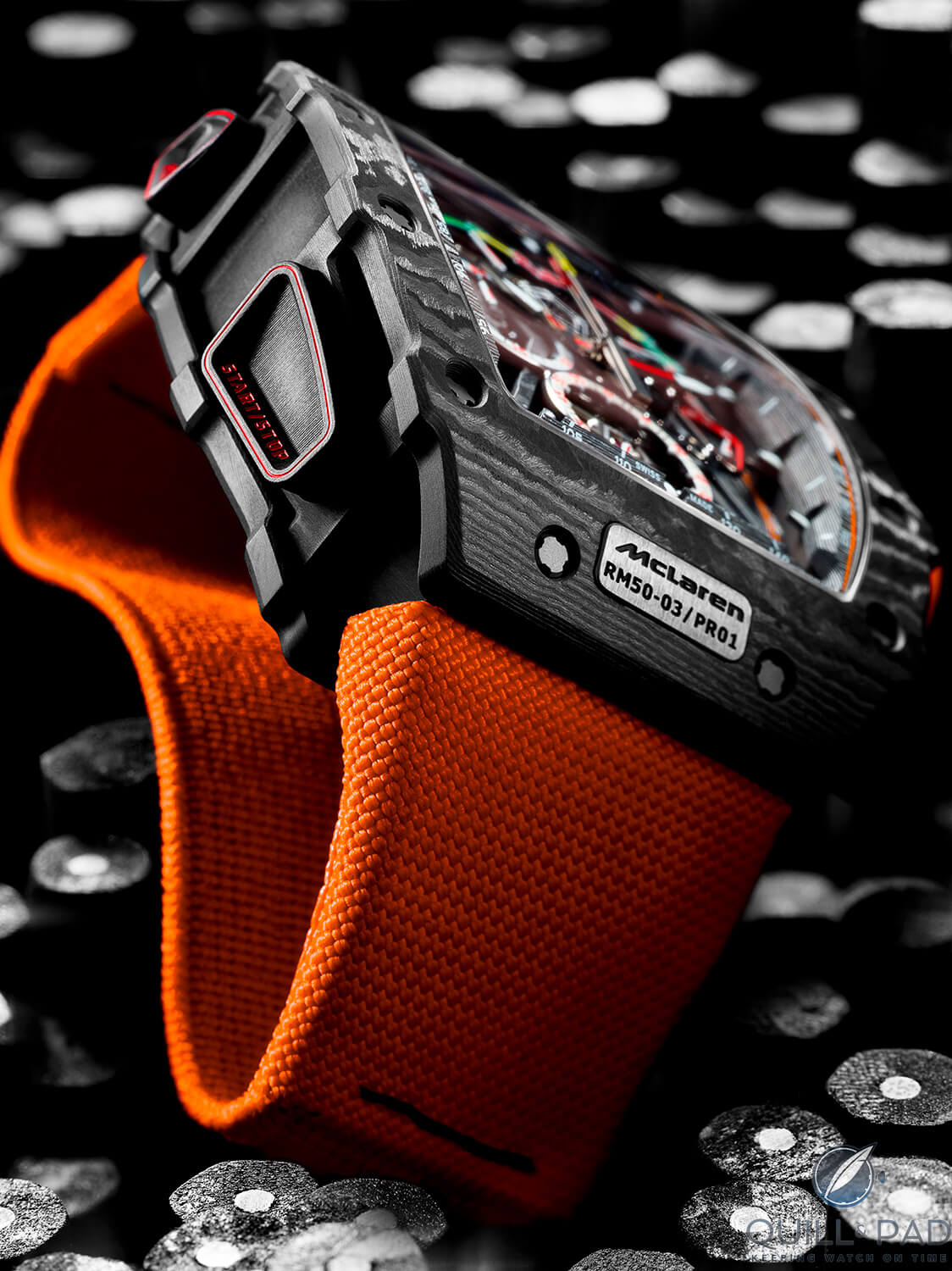
Richard Mille RM 50-03 (photo courtesy Richard Mille/Ted Humble-Smith)
The drivers behind Graph-TPT are a combination of McLaren Applied Technologies, the University of Manchester, North Thin Ply Technology, and the engineers at Richard Mille.
McLaren and McLaren-Honda F1 are in the process of trying to incorporate graphene into the chassis of its single-seater F1 cars, and from the initial research and further work with all the partners involved, Richard Mille was able to find a way to incorporate graphene into the “basic” TPT Carbon.
The method involves combining tiny graphene sheets with the resin used to hold the TPT Carbon layers together. The resulting enhanced resin is less dense and increases inter-laminar shear strength by 50 percent. This means that the Graph-TPT is lighter and 50 percent stronger than regular TPT Carbon.
TPT Carbon where it matters
Since regular TPT Carbon is already made up of hundreds of tiny (0.03 mm) filaments of carbon arranged in parallel layers, alternating 45 degrees between the layers, the Graph-TPT is taking an extreme form of carbon fiber to the next level. The Graph-TPT is utilized for the bezel and case back, while the main case band is still in the normal (for Richard Mille) TPT Carbon. But this isn’t the last place you find graphene in the watch: it’s also injected into the elastic rubber strap.
Working with supplier BIWI S.A., Richard Mille pushed to incorporate graphene into the strap, increasing its elasticity and, almost counter-intuitively, increasing its resistance to wear. The strap is also very light, helping to push the RM 50-03 into the realms of ultra-light watches. Also aiding in that goal is the incorporation of TPT Carbon throughout the movement, replacing bridges, plates, and the entire movement support ring. Now the movement is held by a set of TPT Carbon support arms inspired by the suspension structure of the McLaren-Honda F1 car.
The supports, combined with the use of TPT Carbon throughout the movement and the extensive skeletonization of the titanium components, allow the movement to resist shocks incredibly well. More mass normally means more momentum changing direction during a shock and more susceptibility to damage, so reducing mass makes something more shock resistant.
The movement now weighs a paltry seven grams, keeping the mechanical weight to an absolute minimum. Thanks to the ultra-light mechanism, the RM 50-03 has been extensively tested to withstand instantaneous shocks of 5,000 Gs, 50 times what a human body can survive. For a delicate tourbillon and split-seconds chronograph to have that stability is nearly unheard of – and would be impossible without this dedication to technical advancement for every component.
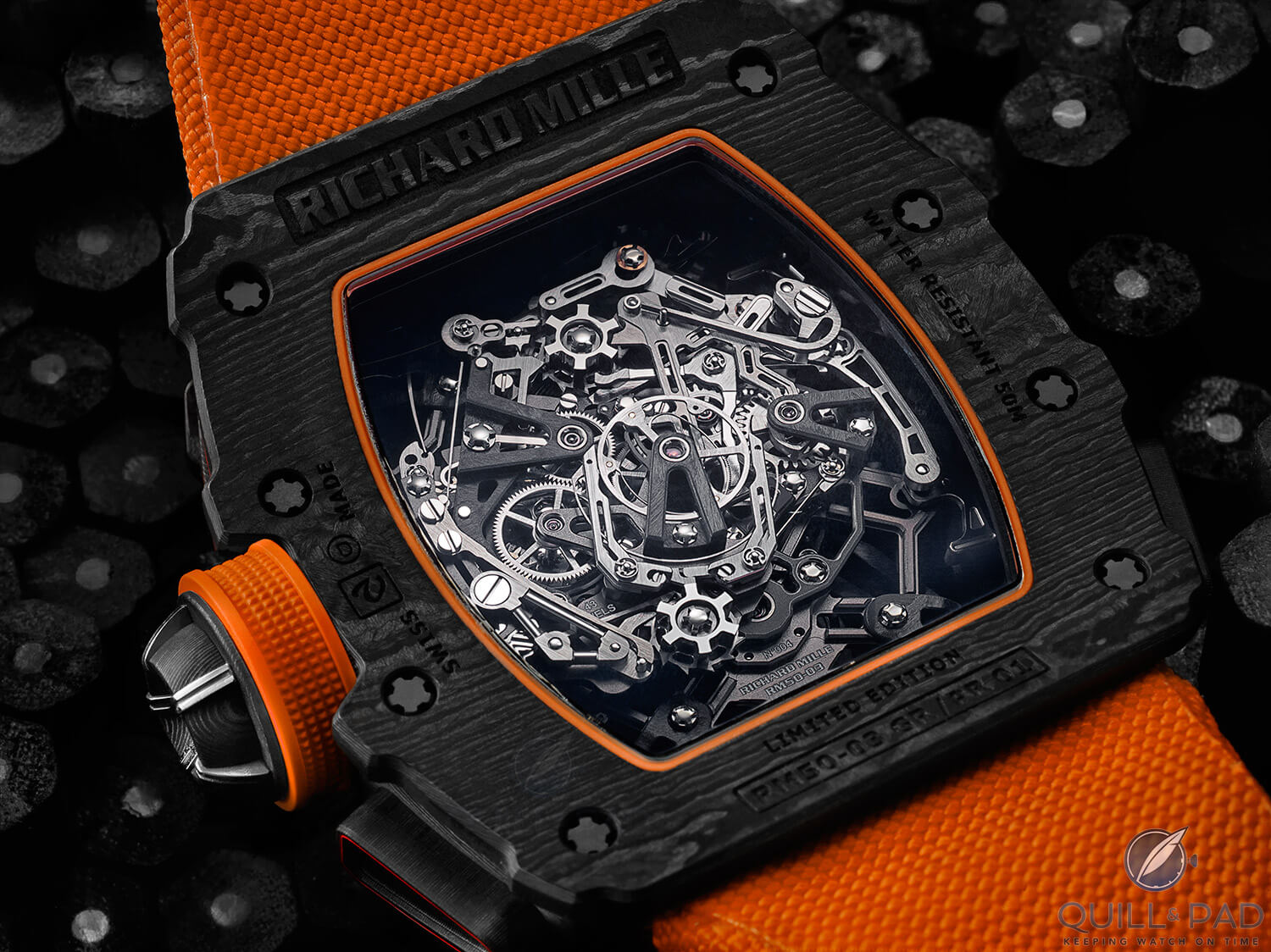
View through the display back to the intricate movement of the Richard Mille RM 50-03 (photo courtesy Richard Mille/Ted Humble-Smith)
Combining the ultra-light movement with the ultra-light carbon case and graphene-enhanced elastic strap results in a complete watch and strap weighing an ultra-light 38 grams. That’s less weight than half a deck of playing cards, yet containing a split-seconds chronograph with tourbillon and 70-hour power reserve, something a half deck of playing cards could only ever dream of!
And yet, Richard Mille didn’t stop at making just the lightest split-seconds chronograph with tourbillon, but developed a better functioning movement too. Collaborating with complicated movement manufacture Audemars Piguet Renaud & Papi (APRP), the chronograph mechanism was overhauled to improve efficiency, reduce friction, and minimize variations introduced from various elements. The column wheel was tweaked to reduce eight columns to six, increasing the simultaneity of the chronograph’s functions and providing a bit more stability to each position.
The split-seconds clamping arm mechanism was revamped to provide more stability when stopping the split-second hand. Also, a blade-style spring has replaced the typically helical or spiral spring on the split-seconds wheel to reduce any torque variation when the mechanism is activated. This ensures a more accurate and consistent rate of timekeeping during chronograph use, a rather important trait for a high-performance chronograph such as this.
The teeth on the barrel and gear train were optimized to reduce torque requirements and friction, which increased efficiency throughout the entire system. The combination of all these improvements had the effect of reducing friction, increasing chronometric performance, and extending the power reserve as seen in its previous iteration within the RM 50-02 Airbus edition.
Subdued visuals of the RM 50-03
The remaining features of the RM 50-03 are actually rather standard for Richard Mille, including a torque-limiting crown, function indicator, power reserve, torque indicator, and chronograph indications. It has a water resistance to 50 meters and while it is sizeable dimension wise, it wears nearly invisibly on the wrist in terms of weight.
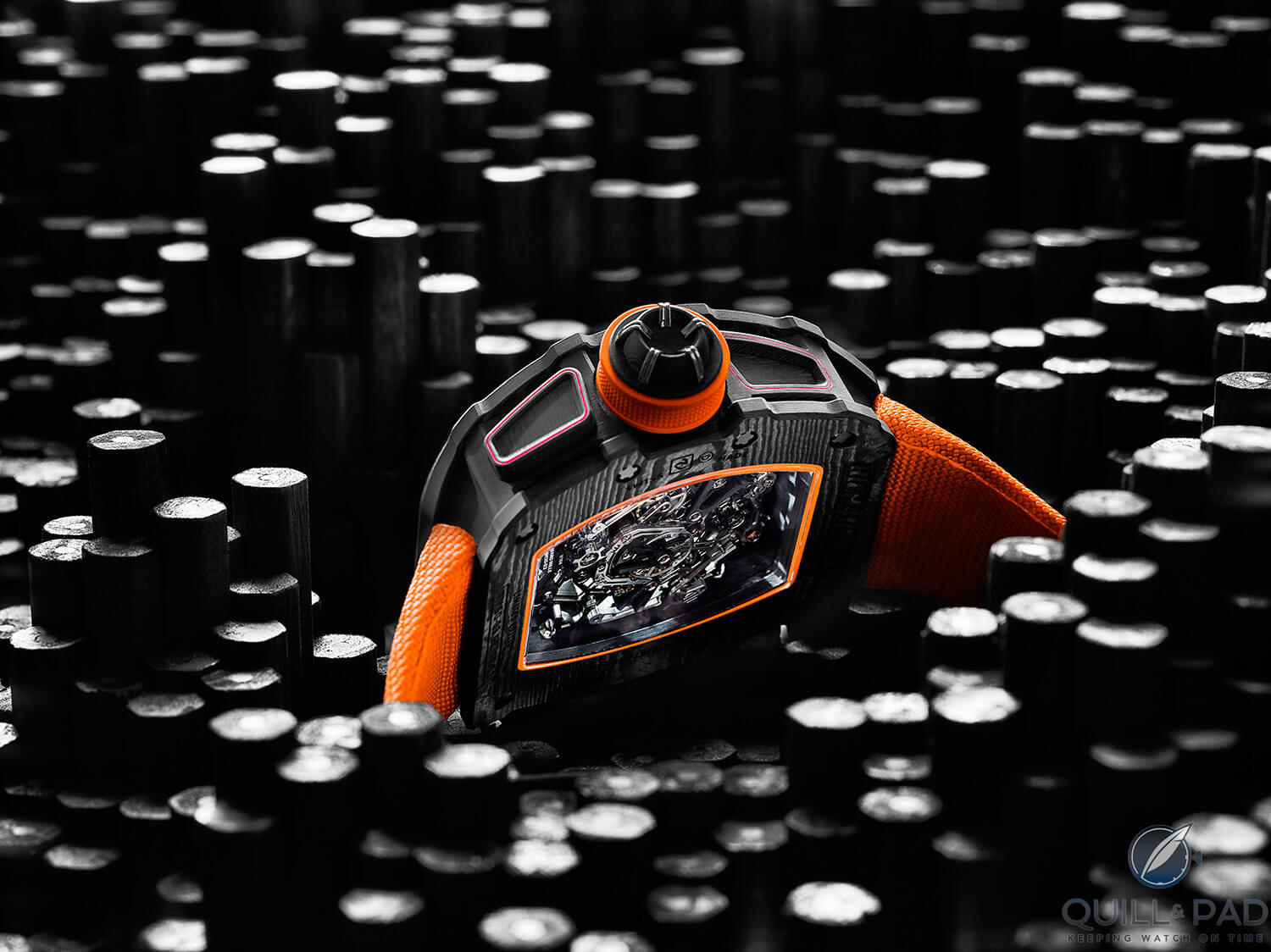
Richard Mille RM 50-03 (photo courtesy Richard Mille/Ted Humble-Smith)
Compared to other models that have come before or been released recently, the RM 50-03 could actually be described as subdued in style and design. The case is black with some orange and red details and triple-colored indicators on the dial, but even those are minimal as are the colors added to the hands. There is a McLaren nameplate on the bottom of the front bezel, and the elastic strap is orange, but even there you have a heavier rubber strap option in black.
All in all, it is a rather stealthy Richard Mille watch as Richard Mille watches go.
The large amount of TPT Carbon in the movement helps to keep visual noise down, and while the dial is a bit busy from all of the skeletonization, it is not as hard to read as you might think. It could be made slightly heavier by adding a solid dial, but what would be the fun in that?
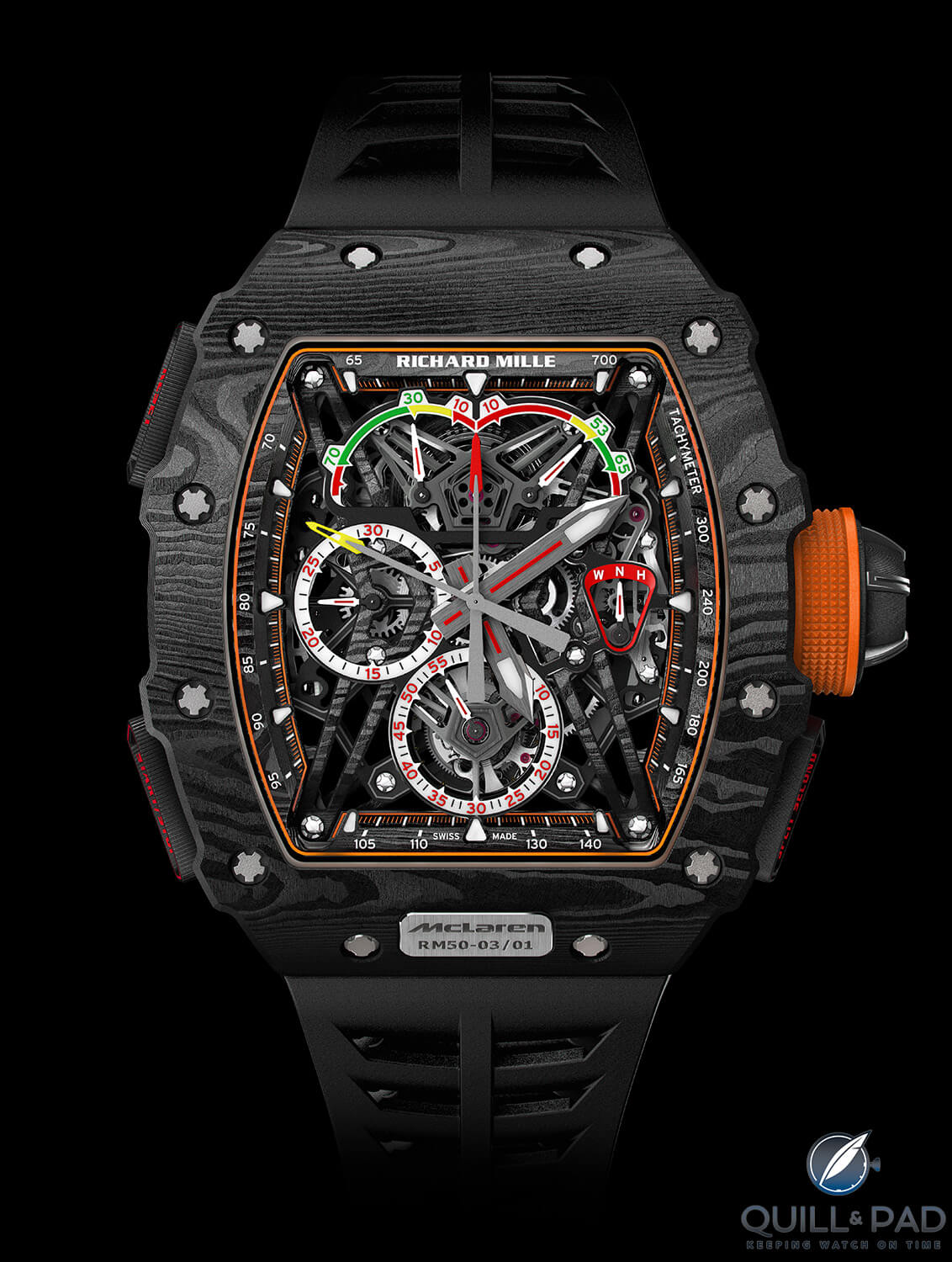
Richard Mille RM 50-03 Tourbillon Split Seconds Chronograph Ultralight McLaren F1
It’s clear what this watch is: an exploration and glorification of material experimentation. The time and effort involved are clearly on display, and really you wouldn’t want it any other way.
Why spend years working with TPT Carbon and months engineering a movement utilizing it as best as possible and then slap a cover on it? That would be silly. One might argue that removing the tourbillon and adding a dial might be a nice compromise that could maintain or even reduce the weight, but Richard Mille is also all about that tourbillon.
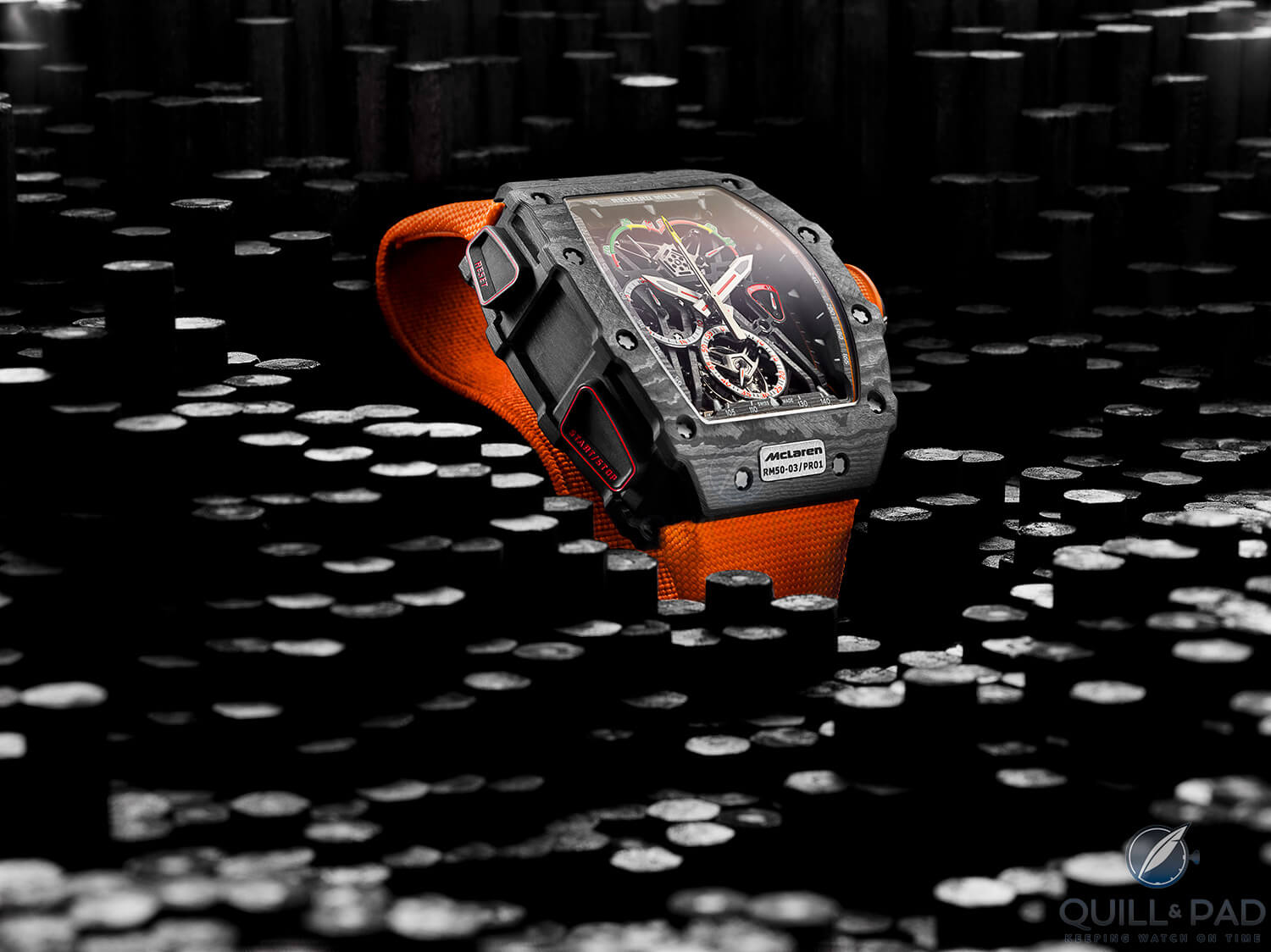
Richard Mille RM 50-03 (photo courtesy Richard Mille/Ted Humble-Smith)
The RM 50-03 is not just a watch (I mean, it is a watch, but stay with me): it is a love letter to ingenuity and innovation. It is a signpost for the beginning of a likely very fruitful relationship between two companies, Richard Mille and McLaren, that intensely pushes the boundaries of what is possible, squeezing out every last drop of awesomeness until the next breakthrough changes the game once again.
What began 51 years ago in Monaco has come full circle in Switzerland and England as passionate people continue to pursue excellence in all forms. The partnership between Richard Mille and McLaren has a bright future ahead with hints at collaborations on GT car projects, and if the RM 50-03 is any indication I imagine we will be seeing quite a few more firsts from the duo.
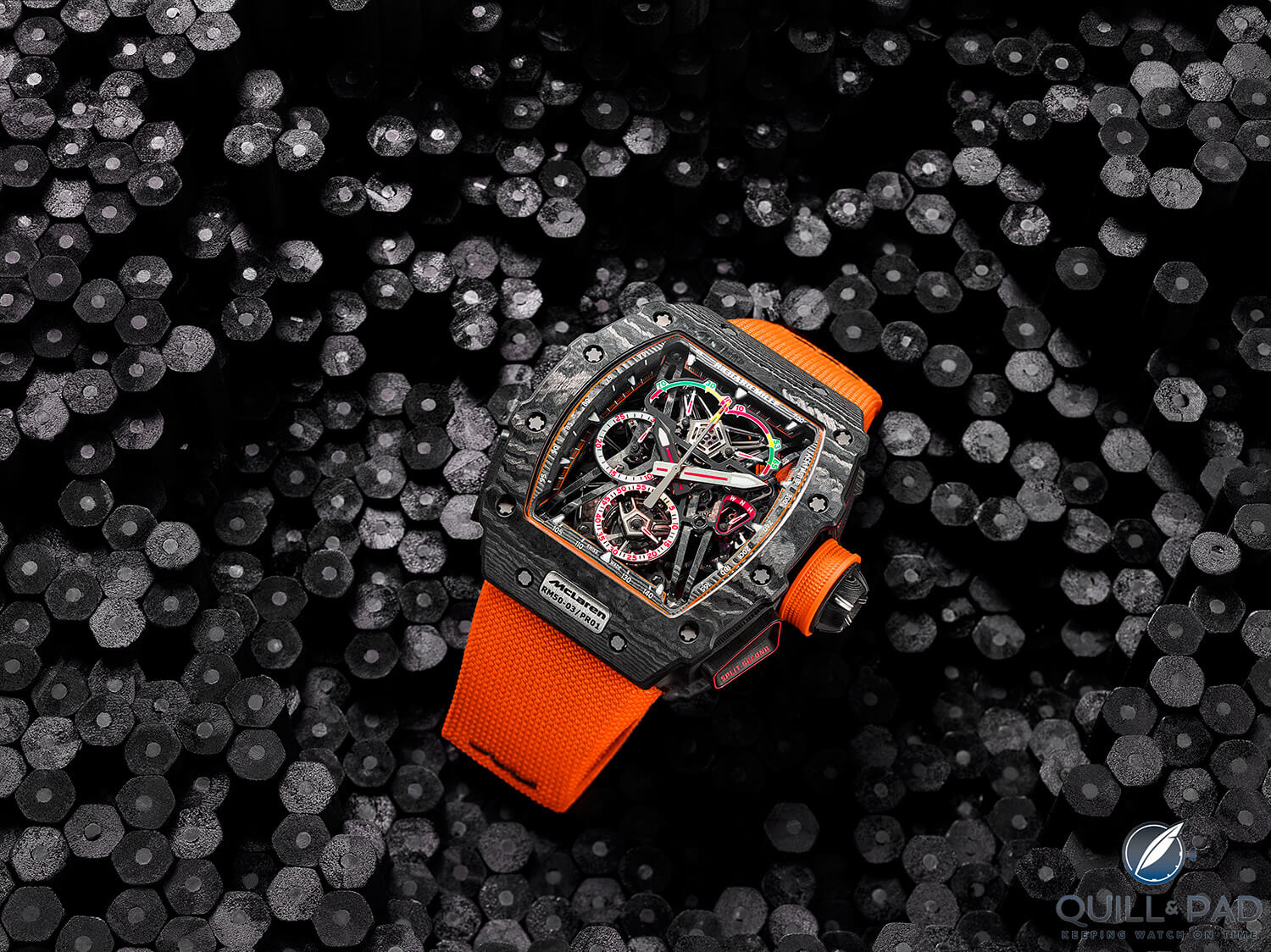
Richard Mille RM 50-03 (photo courtesy Richard Mille/Ted Humble-Smith)
The only thing left is to dream about more moments with the very limited RM 50-03 Tourbillon Split Seconds Chronograph Ultralight McLaren F1. Given its price tag of around a million dollars and the fact that only 75 will ever be made, it seems like my mind will be where I meet with this technical marvel again.
And until then I still have the book that launched the watch! So while I read, how about a breakdown!
- Wowza Factor * 9.1 Compared to some previous Richard Mille models, the RM 50-03 is lower on the wowza factor, yet still scores high due to the still -bold styling!
- Late Night Lust Appeal * 100 » 980.665m/s2 This piece still has a lot of lust appeal, giving 1/50th of the force it’s been tested to handle!
- M.G.R. * 70.5 It’s a split-seconds chronograph with tourbillon, power reserve, torque indicator, and function indicator made with ultra-light TPT Carbon and titanium and weighing in at seven grams. This is one heck of a geeky movement!
- Added-Functionitis * Severe If it was just the split-seconds chronograph, it would be slightly drastic, but including all the other things it actually borders on dangerous. You will definitely need prescription strength Gotta-HAVE-That cream for surprisingly weightless swelling!
- Ouch Outline * 11.2 Stubbing your toe to and from the bathroom in the middle of the night! I don’t think I’m the only one that has ever done this, but it is one of the reasons I just stopped going to the bathroom in the middle of the night. Yet, if it meant I would get this bad boy strapped to my wrist, I would gladly make that midnight trek multiple times!
- Mermaid Moment * How long does it take to strap the watch on? That’s the amount of time before you will be so wowed by how light it is that you will nearly drop your phone trying to call city hall to schedule an appointment before a judge for the ceremony!
- Awesome Total * 936.1 Multiply the dimensions of the case in millimeters (44.5 x 49.65 x 16.1) and divide the result by the weight in grams (38) for a remarkably light awesome total!
For more information, please visit www.richardmille.com/watch/rm-50-03.
Quick Facts Richard Mille RM 50-03
Case: 44.5 x 49.65 x 16.1 mm, Graph-TPT and TPT Carbon
Movement: manual winding Caliber RM50-03 with one minute tourbillon
Functions: hours, minutes, seconds; split-seconds chronograph with 30 minute counter, power reserve, torque indicator, function indicator
Limitation: 75 pieces
Price: $980,000
Trackbacks & Pingbacks
-
[…] This results in one of the strongest carbon cases available, perhaps only surpassed by Richard Mille’s own Graph TPT (see Richard Mille RM 50-03 Tourbillon Split-Seconds Chronograph Ultralight McLaren F1: Born From Cutting… […]
Leave a Reply
Want to join the discussion?Feel free to contribute!

I was reading this at 4 AM, and I enjoyed it so much. Thank you, Joshua. I thought the same last year when Richard Mille and McLaren announced their partnership. It was a match made in heaven, basically. Two companies pushing the technology coming together is the best thing you could ask for. Let’s have our fingers crossed that with the Renault engine, McLaren will be fighting for wins and podiums next year as opposed to the abysmal years they endure with Honda.
You see, this is what I enjoy about Richard Mille. At first, I thought that these watches were insultingly ugly. However, like Greubel Forsey or the new Nike Zoom Cage 3 tennis shoes I got myself for Christmas, they grew on me. Then I found the materials and the craftsmanship. Combining traditional complications with outstanding contributions to science, I just couldn’t get enough of them. Now that is not saying that I can even come close to affording one but hey, one can dream.
i want to like this, the tech is so impressive. but i can’t get past the ugly.
Its the case, it looks like burnt plastic or something not to elegant, the rest ,pretty darn cool ! By the way , this site is horribly to comment in, if you use a tablet !